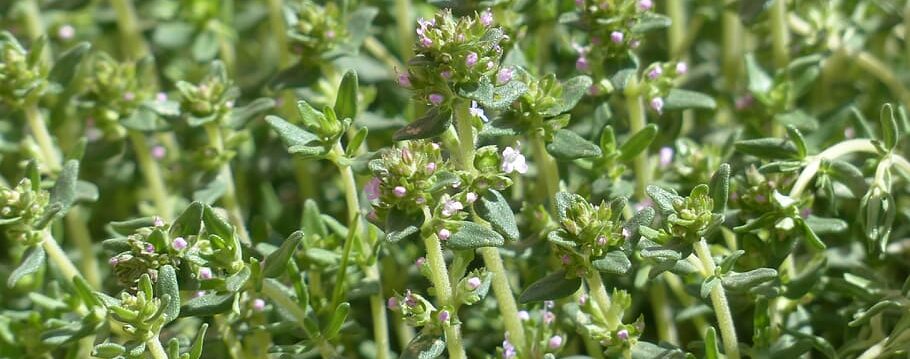THYME RED ESSENTIAL OIL
Thymus ZYGIS L. Y THYMUS VULGARYS l.

thyme red essential oil description
Thyme red essential oil is obtained by steam distillation of the flowery tops of the botanical species Thymus zygis L. and Thymus vulgaris L. chemtype thymol, belonging to the Lamiaceae family.
Thyme red essential oil is the stronger of than other Thyme oils. This oil has a wide spectrum of medicinal uses. Thyme is a perennial aromatic herb with small green-grey leaves and violet or white flowers.
The ancient Greeks, Egyptians and Romans used Thyme as a medicinal herb. The Greeks used it as incense and the Egyptians as part of the embalming process. Thyme became a symbol of bravery and presented to jousting knights in the Middle ages. The people carried Thyme into the courtrooms. They believed holding Thyme would protect them against diseases such as yellow fever.
Interestingly Thyme oil is seven times stronger than carbolic acid, thus useful in hospitals as a disinfectant.
Medical dressings for surgery were soaked in Thyme oil, An old a method of treating wounds which continued up until the First World War.
Today Aromatherapists use thyme red in support of convalescent clients. The added bonus of protecting against any further infections.
Thyme red is components make it chemically more aggressive than Sweet or White Thym. It contains a much higher percent of toxic phenols.
As a result thyme red is advocated for use only by experienced Professional Aromatherapists.
Thymus zygis L. is produced between the months of May to July.
Thyme red oil benefits
Used in aromatherapy applications, cedarwood essential oil is known for its sweet and woody fragrance, which has been characterized as warm, comforting, and sedative, thus naturally promoting stress relief. cedarwood oil’s energizing scent helps to deodorize and freshen indoor environments, while also helping to repel insects. At the same time, its anti-fungal properties help prevent the development of mildew. Its invigorating quality is known to improve cerebral activity, while its calming property is known to relax the body, and the combination of these properties helps to enhance concentration while decreasing hyperactivity. The soothing scent of cedarwood essential oil is reputed to reduce harmful stress and ease tension, which in turn promotes the body’s rest, helps to clear the mind, and subsequently encourages the onset of quality sleep that is both restorative and reparative.
Used cosmetically on the skin, cedarwood essential oil can help soothe irritation, inflammation, redness, and itchiness, as well as dryness that leads to cracking, peeling, or blistering. By regulating sebum production, eliminating acne-causing bacteria, and exhibiting a protective astringent property, cedarwood oil is reputed to guard the skin against environmental pollutants and toxins, thus helping prevent or reduce the chances of future breakouts. Its antiseptic and anti-bacterial properties help to eliminate unpleasant odors, making it an effective deodorizer, and its firming quality helps reduce the appearance of the signs of aging, such as loose and wrinkling skin.
Used in hair, cedarwood oil is known to cleanse the scalp, removing excess oil, dirt, and dandruff. It enhances circulation to the scalp and tightens the follicles, which helps stimulate healthy growth and thereby helps reduce thinning by slowing hair loss.
Used medicinally, cedarwood essential oil’s antiseptic properties are reputed to protect the body against harmful bacteria that are known to cause fungal infections, which can be destructive to the skin and general health. This natural wound-healing quality makes cedarwood oil ideal for application to scrapes, cuts, and other abrasions that require disinfecting. Its anti-inflammatory property makes it well-suited to addressing the discomforts of muscle aches, joint pain, and stiffness, while its antispasmodic property helps to soothe not only coughs but also spasms associated with digestion, respiratory ailments, nerves, and menstruation. As a tonic for overall wellness, cedarwood oil is known to support the health and function of the organs, especially the brain, liver, and kidney.
cedarwood oil is reputed to exhibit an emmenagogue property that regulates menstruation by naturally stimulating circulation, thus benefitting women who suffer from irregular cycles.
thyme red oil organoleptic properties
Thyme red essential oil with a liquid appearance, which has a color that ranges from yellow to red and is characteristic for having an aromatic and phenolic aroma with a slightly spicy base.
Odor
Aromatic and phenolic aroma with a slightly spicy base
Colour
From yellow to red
Appearance
Liquid
thyme red oil components
Major component of thyme red essential oil is thymol. Other components that are present in a lesser proportion, but with significant values, are limonene, p-cymene, gamma-terpinel. Other components are alpha-pinene, myrcene, linalool, beta-caryophyllene, carvacrol methyl ether, carvacrol.
Limonene
Thymol
P-cymene
Gamma-terpinel
Myrcene
Beta-caryophyllene
Carvacrol methyl ether
Carvacrol
C/ Antonio Gómez Millán, nº 29
Parque Tecnológico Citec
41120, Gelves (Seville)
Spain

Tel: +34 955439492
labdassence@labdassence.com
fbm@labdassence.com
Certifications


Nº RGSEAA 31.003179/SE
© Labdassence | SL de Plantas Aromáticas Industrializadas.
VAT ES B28305621 – N° RGSEAA 31.003179/SE





